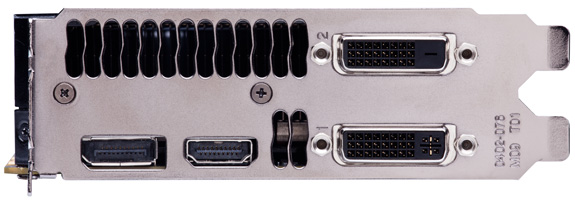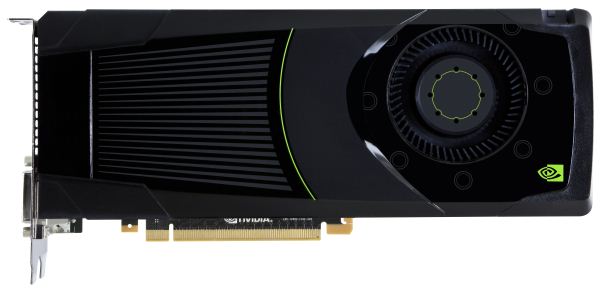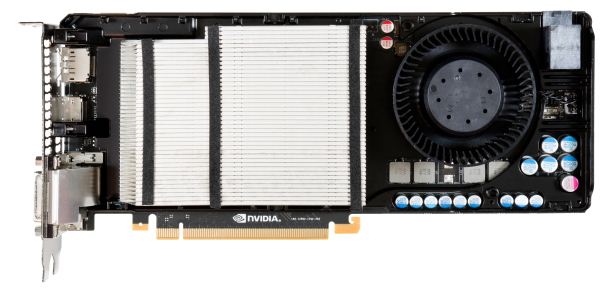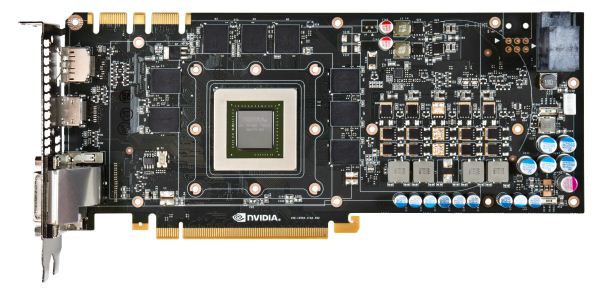NVIDIA GeForce GTX 680 Review: Retaking The Performance Crown
by Ryan Smith on March 22, 2012 9:00 AM ESTMeet the GeForce GTX 680
All things considered the design of the GeForce GTX 680 is not a radical departure from the GTX 580, but at the same time it also has some distinct differences owing to the fact that its TDP is some 50W lower than GTX 580.
Like the past GTX x80 cards, the basic design of the GTX 680 is that of a blower. A radial fan at the rear of the card sucks in air and pushes it towards the front of the card. Notably, due to a combination of card length and the fan position, the “wedge” around the fan has been done away with. NVIDIA tells us that this shouldn’t significantly impact the cooling of the card, particularly since it has a lower TDP in the first place, but when used in SLI it will remove some of the breathing room than the GTX 580 enjoyed.
Looking at the fan itself, compared to the GTX 580 the fan has been moved from the center of the card to the top of the card. This is due to NVIDIA’s port configuration, which uses a stacked DVI connector that consumes what would have normally been part of the exhaust vent on the GTX 580. We’ll get into the port configuration more in a minute, but for the moment the significance is that because the GTX 680 only has half a vent NVIDIA has moved the fan to match the vent, which is why the fan has been moved up.
On that note, the repositioning of the fan also had its own ramifications. Because the fan is now so close to the top and at the same time so close to the rear, NVIDIA went with a unique method of arranging the PCIe power sockets. Rather than having them side-by-side as we’ve seen on countless NVIDIA cards in the past, the sockets are stacked on each other in a staggered configuration. With the fan otherwise occupying the space that one of the sockets would take up, this configuration allowed NVIDIA to have two sockets without lengthening the card just to fit another socket. Overall this staggered design is not too difficult to work with, though with one socket facing the opposite way it might require some cable repositioning if you have a well maintained cable run.
Moving on, when we remove the shroud on the GTX 680 we see the fan, baseplate, and heatsink in full detail. NVIDIA is using an aluminum fin stacked heatsink, very similar to what we saw on the GTX 580. Underneath the heatsink NVIDIA is using a set of three heatpipes to transfer heat between the GPU and the heatsink. This is as opposed to the vapor chamber on the GTX 580, and while this setup doesn’t allow empirical testing, given the high efficiency of vapor chambers it’s likely that this isn’t quite as efficient, though to what degree we couldn’t say.
Finally, after removing the fan, baseplate, and heatsink, we can see the PCB in full detail. Unlike GF110 and GF114, GK104 is not capped with an IHS, allowing for the heatsink to directly come in contact with the GPU die. Meanwhile arranged around the GPU we can see the 8 2Gb GDDR5 RAM modules that give the GTX 680 its 2GB of RAM. These are Hynix R0C modules, which means they’re rated for 6GHz, the stock memory speed for the GTX 680. Overall the card measures 10” long with no overhang from the shroud, making it 0.5” shorter than the GTX 580.
Looking at the top of the card, as always we see the SLI connectors. Following in the footsteps of the GTX 580, the GTX 680 features 2 SLI connectors, allowing for up to 3-way SLI.
Meanwhile at the front of the card we see the I/O bracket. As we alluded to previously, the GTX 680 uses a stacked DVI design here; NVIDIA has done everything they can to keep the DVI ports at the very bottom of the card to avoid impeding airflow, but the upper DVI port still occupies roughly 40% of what would otherwise be the vent. Altogether the GTX 680 features 2 DL-DVI ports, a full size HDMI port, and a full size DisplayPort.

While NVIDIA has used DVI and HDMI ports for quite some time, this is the first time NVIDIA has included DIsplayPort on a reference design. Unfortunately we find that this ruffles our feathers a bit, although this isn’t strictly NVIDIA’s fault. As we’ve covered in the past, DisplayPort comes in both a full size and miniDP configuration – AMD in particular has used miniDP since the Radeon HD 6800 series in 2010. And while we’re happy to see DisplayPort finally make it into an NVIDIA reference design, the fact that it’s a full size DisplayPort is less than encouraging because at this point in time DisplayPort has largely been replaced by miniDP.
Ultimately the fault for this lies more with the VESA than NVIDIA, but it’s indicative of a larger problem in the DisplayPort community in that both full size DP and miniDP are equally valid and equally capable ports. While full size DisplayPort has the distinction of coming first, thanks in large part to Apple it has largely been displaced by miniDP as the most common variant on source devices. The problem with this is that both miniDP and DisplayPort are now in wide use; wide, redundant use.
At this point desktop computers and video cards coming with full size DisplayPorts is silly at best, and frustrating at worst. The laptop guys aren’t going to give up miniDP due to the space savings, and there’s no significantly good reason to use DisplayPort on desktops when miniDP offers the same functionality. We would rather see the PC industry standardize on miniDP across all source devices, and thereby eliminate any ambiguity with regards to what cables or adaptors are necessary. DisplayPort adoption has been slow enough – having 2 variants of the port on source devices only makes it more confusing for everyone.
Finally, while we’re on the subject of display connectivity we quickly took a look at how the idle clockspeeds of GTX 680 are impacted by the use of multiple displays. With 2 displays GTX 680 can utilize its full idle clocks, but only if both displays are connected via a TMDS type connection (DVI/HDMI) and run with identical timings. But if different timings are used or if one display is connected via DisplayPort, then the GTX 680 will shift to its low power 3D clocks. However if we expand that to 3 monitors and enable NVIDIA Surround, then the GTX 680 can operate at full idle regardless of whether DisplayPort is used or not.













404 Comments
View All Comments
jospoortvliet - Thursday, March 22, 2012 - link
Seeing on other sites, the AMD does overclock better than the NVIDIA card - and the difference in power usage in every day scenario's is that NVIDIA uses a few more watts in idle and a few less under load.I'd agree with my dutch hardware.info site which concludes that the two cards are incredibly close and that price should determine what you'd buy.
A quick look shows that at least in NL, the AMD is about 50 bucks cheaper so unless NVIDIA lowers their price, the 7970 continues to be the better buy.
Obviously, AMD has higher costs with the bigger die so NVIDIA should have higher margins. If only they weren't so late to market...
Let's see what the 7990 and NVIDIA's answer to that will do; and what the 8000 and 700 series will do and when they will be released. NVIDIA will have to make sure they don't lag behind AMD anymore, this is hurting them...
theartdude - Thursday, March 22, 2012 - link
Late to market? with Battlefield DLC, Diablo III, MechWarrier Online (and many more titles approaching), this is the PERFECT TIME for an upgrade, btw, my computer is begging for an upgrade right now, just in time for summer-time LAN parties.CeriseCogburn - Tuesday, March 27, 2012 - link
GTX680 overclocks to 1,280 out of the box for an average easy attempt...http://www.newegg.com/Product/Product.aspx?Item=N8...
See the feedback bro.
7970 makes it to 1200 if it's very lucky.
Sorry, another lie is 7970 oc's better.
CeriseCogburn - Tuesday, March 27, 2012 - link
So you're telling me the LIGHTNING amd card is cheaper ? LOLFurther, if you don't get that exact model you won't get the overclocks, and they got a pathetic 100 on the nvidia, which noobs surpass regularly, then they used 2dmark 11 which has amd tessellation driver cheating active.... (apparently they are clueless there as well).
Furthermore, they declared the Nvidia card 10% faster overall- well worth the 50 bucks difference for your generic AMD card no Overclocked LIghtning further overclocked with the special vrm's onboard and much more expensive... then not game tested but benched in amd cheater ware 3dmark 11 tess cheat.
Reaper_17 - Thursday, March 22, 2012 - link
i agree,blanarahul - Tuesday, March 27, 2012 - link
Mr. AMD Fan Boy then you should compare how was AMD doing it since since the HD 5000 Series.6970= 880 MHz
GTX 580=772 MHz
Is it a fair comparison?
GTX 480=702 MHz
HD 5870=850 Mhz
Is it a fair compaison?
According to your argument the NVIDIA cards were at a disadvantage since the AMD cards were always clocked higher. But still the NVIDIA cards were better.
And now that NVIDIA has taken the lead in clock speeds you are crying like a baby that NVIDIA built a souped up overclocked GK104.
First check the facts. Plus the HD 8000 series aren't gonna come so early.
CeriseCogburn - Friday, April 6, 2012 - link
LOL+1
Tell 'em bro !
(fanboys and fairness don't mix)
Sabresiberian - Thursday, March 22, 2012 - link
Yah, I agree here. Clearly, once again, your favorite game and the screen size (resolution) you run at are going to be important factors in making a wise choice.;)
Concillian - Thursday, March 22, 2012 - link
"... but he's correct. The 680 does dominate in nearly every situation and category."Except some of the most consistently and historically demanding games (Crysis Warhead and Metro 2033) it doesn't fare so well compared to the AMD designs. What does this mean if the PC gaming market ever breaks out of it's console port funk?
I suppose it's unlikely, but it indicates it handles easy loads well (loads that can often be handled by a lesser card,) but when it comes to the most demanding resolutions and games, it loses a lot of steam compared to the AMD offering, to the point where it goes from a >15% lead in games that don't need it (Portal 2, for example) to a 10-20% loss in Crysis Warhead at 2560x.
That it struggles in what are traditionally the most demanding games is worrisome, but, I suppose as long as developers continue pumping out the relatively easy to render console ports, it shouldn't pose any major issues.
Eugene86 - Thursday, March 22, 2012 - link
Yes, because people are really buying both the 7970 and GTX680 to play Crysis Warhead at 2560x.... :eyeroll:Nobody cares about old, unoptimized games like that. How about you take a look at the benchmarks that actually, realistically, matter. Look at the benches for Battlefield 3, which is a game that people are actually playing right now. The GTX680 kills the 7970 with about 35% higher frame rates, according to the benchmarks posted in this review.
THAT is what actually matters and that is why the GTX680 is a better card than the 7970.